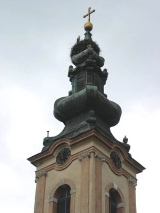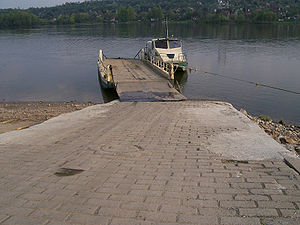
Begec
Encyclopedia
Begeč is a village in Serbia
n province of Vojvodina
. It is located in Novi Sad municipality
, in South Bačka District
. Begeč is situated on the river Danube
, approximately 15 km west from Novi Sad
, on Bačka Palanka
-Novi Sad road. According to 2002 census
, the village has a Serb
ethnic majority and its population numbering 3,360 people.
Cyrillic, the village is known as Бегеч, in Serbian Latin and Croatian
as Begeč, and in Hungarian
as Begecs.
times (3rd-4th century), the fort named Castellum Onagrinum existed at this location, as well as pontoon bridge that was used by Romans
during the war with the Sarmatians
.
Begeč was first mentioned in the 16th century and its name derived from the Ottoman
ruling title "beg" (or "bey
") and word "eč" (meaning "village"), hence the full meaning of the name would be "the village of the beg". There is a Serb Orthodox
church from 1838 in the village.
, Veternik
and Novi Sad
. Village is also on bus route from Bač and Bačka Palanka
to Novi Sad.
Besides buses and roads, Begeč is connected by river ferry
to village of Banoštor
in Syrmia
, across Danube
river. For pedestrians and bicycles it is free of charge, cars pay toll of 200 Serbian dinar
s (approximately 2 Euro
s).

Serbia
Serbia , officially the Republic of Serbia , is a landlocked country located at the crossroads of Central and Southeast Europe, covering the southern part of the Carpathian basin and the central part of the Balkans...
n province of Vojvodina
Vojvodina
Vojvodina, officially called Autonomous Province of Vojvodina is an autonomous province of Serbia. Its capital and largest city is Novi Sad...
. It is located in Novi Sad municipality
Novi Sad municipality
City Municipality of Novi Sad is one of two city municipalities which comprise the City of Novi Sad in Serbia. The population of the municipality include approximately 335,000 people.-Politics:...
, in South Bačka District
South Backa District
South Bačka District is a northern district of Serbia. It lies in the southern part of Bačka and northern part of Syrmia, in the autonomous province of Vojvodina. It has a population of 607,835...
. Begeč is situated on the river Danube
Danube
The Danube is a river in the Central Europe and the Europe's second longest river after the Volga. It is classified as an international waterway....
, approximately 15 km west from Novi Sad
Novi Sad
Novi Sad is the capital of the northern Serbian province of Vojvodina, and the administrative centre of the South Bačka District. The city is located in the southern part of Pannonian Plain on the Danube river....
, on Bačka Palanka
Backa Palanka
Bačka Palanka is a city and municipality located in Serbia, on left bank of the Danube, at 45.15° North, 19.24° East...
-Novi Sad road. According to 2002 census
Census
A census is the procedure of systematically acquiring and recording information about the members of a given population. It is a regularly occurring and official count of a particular population. The term is used mostly in connection with national population and housing censuses; other common...
, the village has a Serb
Serbs
The Serbs are a South Slavic ethnic group of the Balkans and southern Central Europe. Serbs are located mainly in Serbia, Montenegro and Bosnia and Herzegovina, and form a sizable minority in Croatia, the Republic of Macedonia and Slovenia. Likewise, Serbs are an officially recognized minority in...
ethnic majority and its population numbering 3,360 people.
Name
In SerbianSerbian language
Serbian is a form of Serbo-Croatian, a South Slavic language, spoken by Serbs in Serbia, Bosnia and Herzegovina, Montenegro, Croatia and neighbouring countries....
Cyrillic, the village is known as Бегеч, in Serbian Latin and Croatian
Croatian language
Croatian is the collective name for the standard language and dialects spoken by Croats, principally in Croatia, Bosnia and Herzegovina, the Serbian province of Vojvodina and other neighbouring countries...
as Begeč, and in Hungarian
Hungarian language
Hungarian is a Uralic language, part of the Ugric group. With some 14 million speakers, it is one of the most widely spoken non-Indo-European languages in Europe....
as Begecs.
History and culture
In the RomanRoman Empire
The Roman Empire was the post-Republican period of the ancient Roman civilization, characterised by an autocratic form of government and large territorial holdings in Europe and around the Mediterranean....
times (3rd-4th century), the fort named Castellum Onagrinum existed at this location, as well as pontoon bridge that was used by Romans
Ancient Rome
Ancient Rome was a thriving civilization that grew on the Italian Peninsula as early as the 8th century BC. Located along the Mediterranean Sea and centered on the city of Rome, it expanded to one of the largest empires in the ancient world....
during the war with the Sarmatians
Sarmatians
The Iron Age Sarmatians were an Iranian people in Classical Antiquity, flourishing from about the 5th century BC to the 4th century AD....
.
Begeč was first mentioned in the 16th century and its name derived from the Ottoman
Ottoman Empire
The Ottoman EmpireIt was usually referred to as the "Ottoman Empire", the "Turkish Empire", the "Ottoman Caliphate" or more commonly "Turkey" by its contemporaries...
ruling title "beg" (or "bey
Bey
Bey is a title for chieftain, traditionally applied to the leaders of small tribal groups. Accoding to some sources, the word "Bey" is of Turkish language In historical accounts, many Turkish, other Turkic and Persian leaders are titled Bey, Beg, Bek, Bay, Baig or Beigh. They are all the same word...
") and word "eč" (meaning "village"), hence the full meaning of the name would be "the village of the beg". There is a Serb Orthodox
Serbian Orthodox Church
The Serbian Orthodox Church is one of the autocephalous Orthodox Christian churches, ranking sixth in order of seniority after Constantinople, Alexandria, Antioch, Jerusalem, and Russia...
church from 1838 in the village.
Transport
Village is connected to Novi Sad by a public bus line 56, which operates daily and connect Begeč with FutogFutog
Futog is a town in Serbia, in the Autonomous Province of Vojvodina. It is part of the metropolitan area of Novi Sad.-Name:The name Futog derives from Old Church Slavonic term for “on the mouth” - vo utok ....
, Veternik
Veternik
Veternik is a suburban settlement near Novi Sad, Serbia. It is located between Novi Sad and Futog. Its population numbers 16,895 and most of its inhabitants are ethnic Serbs...
and Novi Sad
Novi Sad
Novi Sad is the capital of the northern Serbian province of Vojvodina, and the administrative centre of the South Bačka District. The city is located in the southern part of Pannonian Plain on the Danube river....
. Village is also on bus route from Bač and Bačka Palanka
Backa Palanka
Bačka Palanka is a city and municipality located in Serbia, on left bank of the Danube, at 45.15° North, 19.24° East...
to Novi Sad.
Besides buses and roads, Begeč is connected by river ferry
Ferry
A ferry is a form of transportation, usually a boat, but sometimes a ship, used to carry primarily passengers, and sometimes vehicles and cargo as well, across a body of water. Most ferries operate on regular, frequent, return services...
to village of Banoštor
Banoštor
Banoštor is a village in Serbia. It is situated in the Beočin municipality, in the Vojvodina province. Although, the village is geographically located in Syrmia, it is part of the South Bačka District. The village has a Serb ethnic majority and its population numbering 780 people .-Name:The name...
in Syrmia
Syrmia
Syrmia is a fertile region of the Pannonian Plain in Europe, between the Danube and Sava rivers. It is divided between Serbia in the east and Croatia in the west....
, across Danube
Danube
The Danube is a river in the Central Europe and the Europe's second longest river after the Volga. It is classified as an international waterway....
river. For pedestrians and bicycles it is free of charge, cars pay toll of 200 Serbian dinar
Serbian dinar
The dinar is the currency of Serbia. An earlier currency also called dinar was used in Serbia between 1868 and 1918. The earliest use of the dinar date to 1214. Today's Serbian dinar is a continuation of the last Yugoslav dinar...
s (approximately 2 Euro
Euro
The euro is the official currency of the eurozone: 17 of the 27 member states of the European Union. It is also the currency used by the Institutions of the European Union. The eurozone consists of Austria, Belgium, Cyprus, Estonia, Finland, France, Germany, Greece, Ireland, Italy, Luxembourg,...
s).

Famous residents
The famous residents of Begeč are footballers:- Vujadin BoškovVujadin BoškovVujadin Boškov is a retired Serbian football player and coach.Boškov was born in the village of Begeč near Novi Sad, Danube Banovina, Kingdom of Yugoslavia). He played with FK Vojvodina for most of his career...
- Radomir Krstić
- Lazar Vasić

